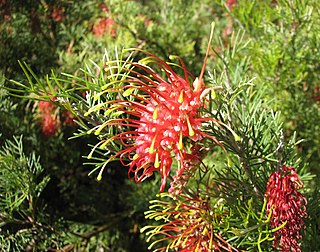
Grevillea thelemanniana, commonly known as spider net grevillea, is species of flowering plant in the family Proteaceae and is endemic to Perth, Western Australia. It is a spreading shrub with linear and pinnatipartite to pinnatisect leaves with linear to narrowly elliptic lobes, and clusters of 6 to 14 pinkish-red and cream-coloured flowers with a red, green-tipped style.

Grevillea vestita is species of flowering plant in the family Proteaceae and is endemic to the south-west of Western Australia. It is an erect, spreading, prickly shrub with lobed leaves, the number and arrangement of lobes depending on subspecies, and more or less spherical to dome-shaped clusters of hairy, white to cream-coloured flowers sometimes tinged with pink.

Grevillea umbellulata is species of flowering plant in the family Proteaceae and is endemic to the south-west of Western Australia. It is a spreading shrub that forms a lignotuber, has linear to narrowly elliptic leaves, and cylindrical clusters of hairy, white to cream-coloured flowers often tinged with grey or pink.

Grevillea drummondii, commonly known as Drummond's grevillea, is a species of flowering plant in the family Proteaceae and is endemic to the south-west of Western Australia. It is a low, spreading to erect shrub with narrowly elliptic to narrowly egg-shaped leaves with the narrower end towards the base, and dense groups of cream-coloured flowers that turn pink or red as they age.
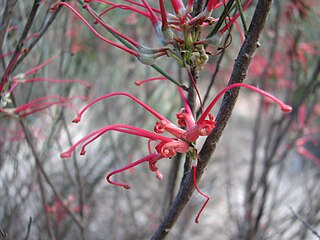
Grevillea sarissa, commonly known as wheel grevillea, is a species of flowering plant in the family Proteaceae and is native to South Australia and Western Australia. It is a spreading shrub, usually with linear leaves, and more or less erect, wheel-like to more or less spherical clusters of red or yellow flowers.
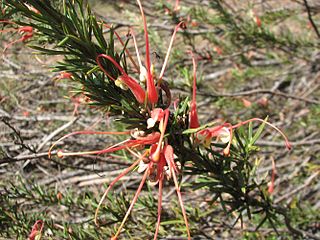
Grevillea tripartita is species of flowering plant in the family Proteaceae and is endemic to the south-west of Western Australia. It is an erect, prickly shrub with divided leaves with 3 lobes, and clusters of red and cream-coloured or reddish-orange and yellow flowers.

Thomasia macrocarpa, commonly known as large-fruited thomasia, is a shrub that is endemic to the southwest of Western Australia.
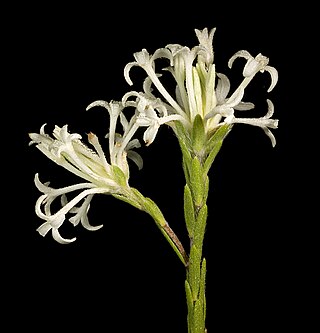
Pimelea longiflora is a species of flowering plant in the family Thymelaeaceae and is endemic to the southwest of Western Australia. It is an erect, spindly shrub with linear to narrowly elliptic leaves and erect clusters of white to cream-coloured flowers, surrounded by 4 to 6 green, egg-shaped involucral bracts.

Grevillea scabra, commonly known as the rough-leaved grevillea, is a species of flowering plant in the family Proteaceae and is endemic to the south-west of Western Australia. It is a low, open shrub with clusters of narrowly elliptic to more or less linear leaves and small clusters of white to cream-coloured flowers.

Dasymalla terminalis, commonly known as native foxglove, is a flowering plant in the mint family Lamiaceae and is endemic to the south-west of Western Australia. It is a shrub with its branches, leaves and some of its flower parts densely covered with white, woolly hairs. The leaves are thick and soft and the flowers are tube-shaped, pale to deep pinkish-purple or claret red.
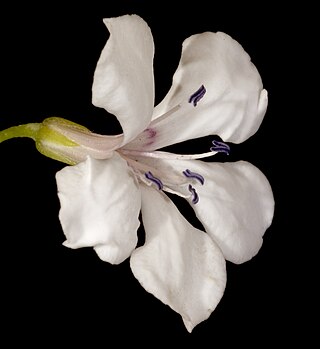
Marianthus candidus, commonly known as white marianthus, is a species of flowering plant in the family Pittosporaceae and is endemic to the south-west of Western Australia. It is a twining shrub or climber with elliptic leaves and white flowers arranged in groups of twenty to thirty and becoming fawn or pink as they age.
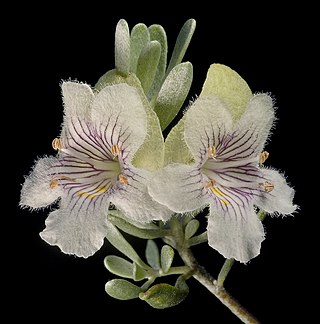
Prostanthera althoferi is a species of flowering plant in the family Lamiaceae and is endemic to inland areas of Australia. It is an erect shrub with its stems and leaves densely covered with silvery, greyish-green hairs, and has narrow egg-shaped leaves and white to cream-coloured flowers with mauve or purple striations inside.

Lasiopetalum bracteatum, commonly known as Helena velvet bush, is a species of flowering plant in the family Malvaceae and is endemic to the south-west Western Australia. It is an erect, spreading shrub with egg-shaped leaves and loose groups pinkish flowers.
Pimelea drummondii is a species of flowering plant in the family Thymelaeaceae and is endemic to near-coastal areas of southern Western Australia. It is an erect, slender shrub with narrowly elliptic or elliptic leaves arranged in opposite pairs, and white or cream-coloured flowers surrounded by 3 or 4 pairs of pale green to yellowish involucral bracts.
Cryptandra micrantha is a flowering plant in the family Rhamnaceae and is endemic to the southwest of Western Australia. It is a prostrate or upright shrub with spiny branchlets, narrowly oblong to elliptic leaves and dense clusters of white or cream-coloured, tube-shaped flowers.
Conostephium laeve is a species of flowering plant in the family Ericaceae and is endemic to the west of Western Australia. It is a compact shrub with erect, narrowly elliptic or narrowly egg-shaped leaves with the narrower end toward the base, and pendulous, spindle-shaped, cream to straw-coloured and pink flowers.

Stenanthemum pomaderroides is a species of flowering plant in the family Rhamnaceae and is endemic to the southwest of Western Australia. It is an erect shrub with densely hairy young stems, egg-shaped leaves with the narrower end towards the base, and cream-coloured clusters of 10 to 30 tube-shaped flowers.
Conostephium papillosum is a species of flowering plant in the family Ericaceae and is endemic to the south of Western Australia. It is a compact shrub with erect, narrowly elliptic or narrowly egg-shaped leaves with the narrower end toward the base, and pendulous, spindle-shaped, cream to straw-coloured and dark purple flowers.

Billardiera floribunda, commonly known as white-flowered billardiera, is a species of flowering plant in the family Pittosporaceae and is endemic to the south-west of Western Australia. It is a robust twining shrub or climber that has thick, leathery, elliptic leaves and white or pinkish flowers arranged in groups of ten or more.
Marianthus coeruleopunctatus, commonly known as blue-spotted marianthus, is a species of flowering plant in the family Pittosporaceae and is endemic to the southwest of Western Australia. It is a twining shrub or climber with narrowly elliptic leaves and pale blue flowers sometimes with dark blue spots or lines, arranged in branched clusters.
















